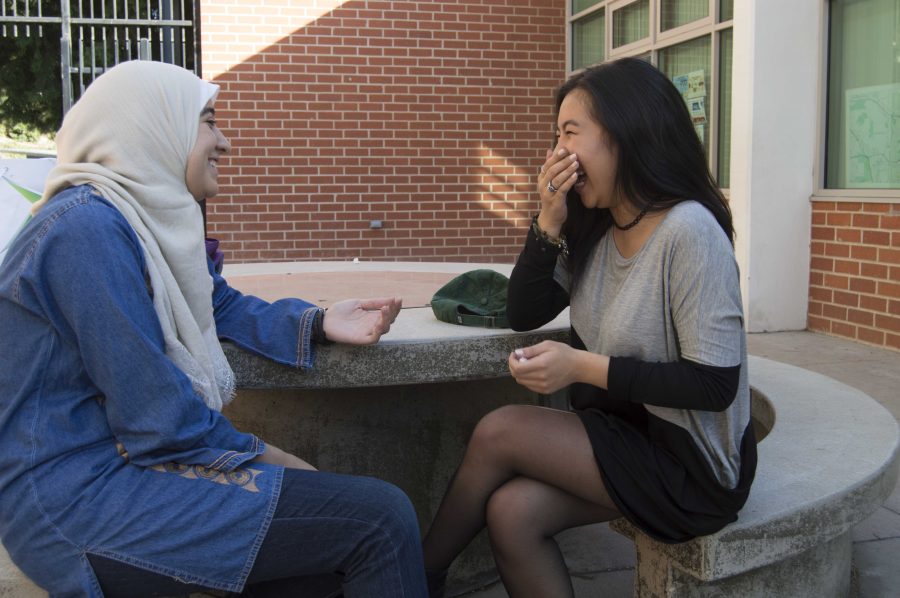Seniors Jada Javier and Fatma Abdel Rahman are discussing ASB businesses. Both are born outside of America and are now members of the school government.
Immigration’s positive effects help the U.S.
Immigration has many positive effects, according to studies and personal stories from students.
From the Great Wall of Trump to Pres. Obama’s intention to allow 10,000 Syrian refugees to enter the U.S., discussion over the topic of immigration has spread across the nation. One of the issues many Americans seem to have with immigration is that immigrants will overpopulate the country and spend unnecessary resources. Senior Trey Sanbar’s story, however, shows just the opposite.
Trey Sanbar’s uncle, Chakib Sambar, was born in Palestine. During the Israeli-Palestinian conflict in the late 1940s, however, Sambar was forced to survive outside, homeless as a bomb blew apart his home. Pushing through hardship, Sambar made it to the United States in his teenage years, where he graduated from Harvard. Afterwards, over many years of working in Southern California, he held several jobs in the field of education, including being a high school teacher, an Adjunct professor of the English Department, both a Vice-President and a President of Crescenta Valley Chamber of Commerce, and a President of the GUSD Board of Education for three terms.
However, according to the Pew Research Center, at least 41 percent of Americans, will still argue that immigrants, like Sambar, steal jobs and harm the American economy, bringing down its businesses.
The argument that immigration, especially illegal immigration, harms the economy is true, somewhat. According to New York Times, illegal, or undocumented workers, have lowered wages for U.S. adults without highs school diploma anywhere between 0.4 to 7.4 percent. However the number of adults that fall into this category in US is only 15 percent of the entire population.
Most immigrants, both legal and illegal, however, strive toward more high class positions in STEAM (science, technology, engineering, arts, and mathematics) fields. One such example is Senior Jada Javier.
Javier came to America from the Philippines. Back in the Philippines, Javier said that she wouldn’t attend a public school due to the system’s negative reputation, and instead she went to a private school. “Back there public schools were bad,” Javier said. “I was even slightly worried about schools here, but I was very glad I got into them when I did.”
Now Javier is at the top of her classes, is renowned for her writing, and is the Student Store Commissioner for ASB. She looks forward to a career in psychology. “I want to be a licensed psychologist and help people,” she said. “Occasionally, I also want to go to shelters and provide free therapies for the less fortunate.”

Sophomore Rosalind Villa, while born here, left to Mexico and grew up there. Returning here she is excited with the opportunity to explore the field of engineering.
Sophomore Rosalinda Villa said that she appreciates her educational opportunities in the United States, hoping to enter into STEAM fields. She lived five years in Mexico and now that she is in USA she strives to explore the field of engineering. “I have a love for tinkering with technology and fixing things up,” Villa said. “I hope to get a career somewhere in that field.”
However, these examples may seem to support arguments that state that immigrants like Javier and Villa steal STEAM-related jobs. Yet these arguments, too, are incorrect. The American Immigration Lawyers Association found that most studies have shown that foreign-born STEM workers coming to the US showed 10-25 percent productivity growth between 1990 and 2010. On the other hand, there are not enough US-born, college-educated STEM professionals to fill all the available jobs.
In fact, a survey in 2011 proved that STEM-related fields had the lowest unemployment rate, 3.15 percent, while the rest of the nation was up to 8 percent unemployment. And yet many immigrants can still be made to feel bad.
One example of an immigrant being made to feel bad would be senior Fatma Abdel Rahman. She dreams of becoming a scholar in Muslim history and sociology. However, she could never shake off a specific negative feeling that made her feel bad. “I often felt like people thought I was stupid during the first few years I was here,” Abdel Rahman said. “People always acted incredibly surprised at how fluent my English was, just because I wasn’t a native born.”
And yet, Abdel Rahman is determined to achieve her goals. In fact, if the immigration influx was cut, there would be a huge percentage of vacant jobs.
